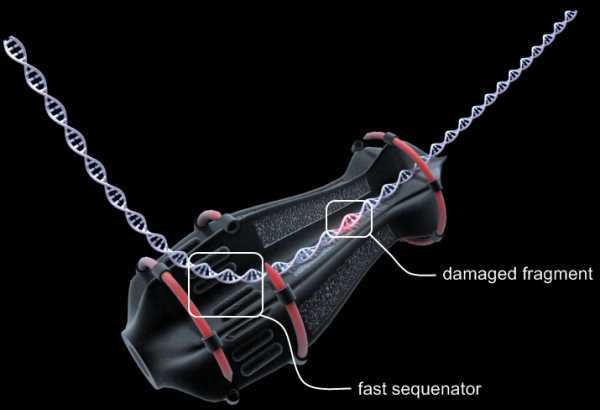Five decades of research and application of computers in biomedicine has given rise to the development of medical informatics, which has made many advancements in genomic and translational medicine possible. DNA repairing nanorobots biomedical animation was created to show a possible future of biomedicine.
Development in nanotechnology and nanorobotics are opening up the possibilities for nanomedicine and regenerative medicine where informatics and DNA computing can become a catalyst for their application in health-related issues at a sub-molecular or atomic level.
While nanomedicine promises a new frontier for clinical practice and biomedical research, some issues remain challenging, for example, cost-effectiveness, long-lasting clinical trials, methods of drug delivery and the implementation of new personalized therapies.
DNA damage, due to environmental factors and standard metabolic processes inside a cell, occurs at a rate of 1,000 to 1,000,000 molecular lesions in each cell per day.The vast majority of DNA damage affects the primary structure of the double helix. These alterations can, in turn, disrupt the molecules’ regular helical structure by adding non-native chemical bonds or bulky DNA adduct that do not fit in a standard double helix. Unlike proteins and RNA, DNA usually lacks a tertiary structure, and therefore damage or disturbance does not occur at that level.DNA repair nanorobotics will go through the same process that has already been proved possible. The access to cells is possible just like biologists can pierce needles into cells without affecting them. That’s how molecular machines are capable of entering the cell.Also, all specific biochemical interactions show that these molecular systems can recognize other molecules, build or restructure every molecule in a cell, and can dismantle damaged molecules. Finally, cells that replicate prove that molecular systems can assemble every system found in a cell. Therefore, since nature has demonstrated the basic operations needed to perform molecular-level cell repair, in the future, nanomachine based systems will be built to be able to enter cells, sense differences from the healthy ones and modify its structure.The possibilities of these machines are impressive. As they can open and close cell membranes or travel through tissue and enter them, these machines will be able to correct a single molecular disorder like DNA damage or enzyme deficiency. Later, more abilities could be programmed into these nanorobots with the help of advanced AI systems. Powerful nanocomputers and fast sequenators will be needed to guide these machines.These computers will guide nanorobots to examine, take apart and rebuild damaged molecular structures. This machines will be able to repair a whole cell. Continue with another cell to forming tissue and ending with an entire organ. Finally, restoring the body.
Nanobot Medical Animation Studio provides its own vision of DNA-repairing nanorobots. This type of molecular machine can attach DNA strands and remove broken fragments. A special express DNA-sequenator analyzes all DNA and cuts off damaged nucleotide or unwanted genes. This model is based on a concept of a diamondoid nano-robot by Robert Freitas Jr. We hope to see more progress in the near future.

DNA-repair nanobot description

Nanobot Medical Animation Studio develops highly innovative digital graphics to depict actual and conceptual technologies by a synergistic fusion of art and science since 2007. Nanobot provides visually engaging digital solutions like scientific VR/AR/MR, 3D medical animations, illustrations for innovative marketing and training | education strategies to the pharmaceutical and biotech industry.We are devoted entirely to medical and scientific imaging. Our creative production team and experienced medical experts help us produce visually and scientifically accurate media material to make any project a huge success.We are a professional medical animation and interactive design company whose team has a long history of experience in the creation of latter-day colorful photo-realistic animated or static images.
Our client ranges from the Medical Device, Pharmaceutical and Biotechnology Industry, as well as Educational Institutes, Medical Marketing Companies, and Healthcare Agencies Globally.






